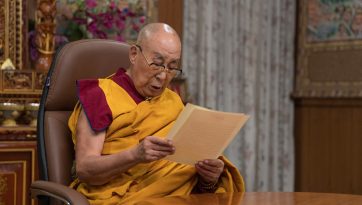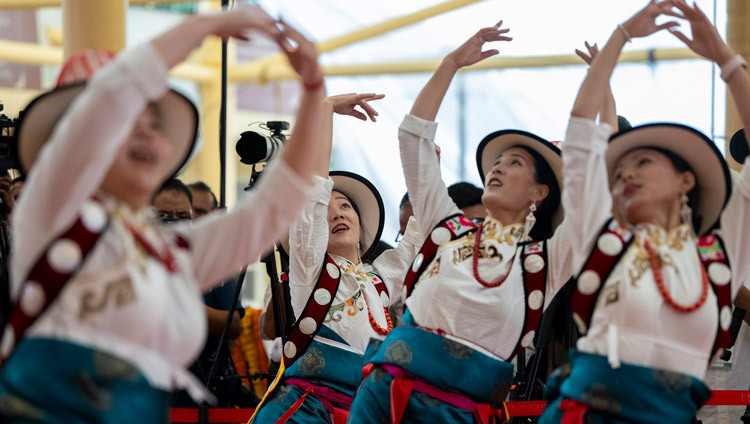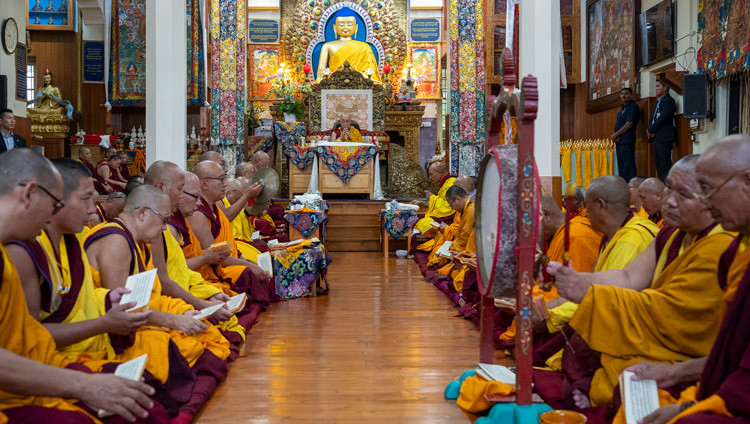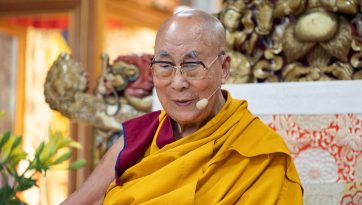Kalon Pema Chhinjor Addresses World Pilgrimage Festival in Korea
Below is the full text of the Kalon Pema Chhinjor’s speech at the World Pilgrimage Festival in South Korea on Sunday (11 November).
PILGRIMAGE AND RELIGIOUS HARMONY
First of all, I would like to convey my heartfelt “Tashi Delek” to the venerable sanghas, distinguished participants, and Korean people on behalf of myself and the Central Tibetan Administration, based in Dharamsala, India.
This is indeed a great privilege for me to represent Tibetan people and share some information about Tibet and its religion and culture. I would like to say “Thank you” to the organizers for kindly extending me an invitation to this event.
I would like to say few words about Tibet. Tibet is strategically and centrally located at the heart of central Asia. The area covers around 2.5 million square kilometers. Eastern part of Tibet touches to China and western to India. Despite vast areas, population is only six million. This is because nearly fifteen percent of males go to monastery as monk and five percent as nuns. They do not marry, and therefore, there is no reproduction.
Tibet is said to be located at the “Roof of the World” as the land surface in average rises 4900 meters above sea level. It is also known as the “Land of Snows” because of its border encircled by Snow Mountains. It is very rich with natural and mineral resources and all Asia’s major rivers originate from Tibet. It has also served as buffer state between two most populace Asian countries, India and China.
Before Buddhism arrived in Tibet, Tibetans followed an ancient native religion called Bon, which is to some extend very similar to Buddhism. They have their own monasteries and nunneries.
Buddhism was introduced in Tibet in seven century during the reign of thirty-third King Songtsen Gampo (608-650). He sent his minister Thomi Sambhota to India for learning. And, after returning from India, Thomi Sambhota invented Tibetan script based on Sanskrit script. King Songtsen Gampo married a Nepalese and Chinese princess and they brought two very ancient and holy statues of Lord Buddha to Tibet. These two statues were enshrined in Jokhang and Ramoche temples, which are considered holiest places in Tibet. In 637, he built the famous Potala palace which was expanded by the great fifth Dalai Lama.
People from all parts of Tibet strive to visit holy places of Lhasa, the Land of God, which is the Capital City of Tibet. They make pilgrimage to Jokhang temple. There’s a common saying: one should be able to visit Jokhang temple and seek blessing of Jowo Rinpoche before death.
The thirty-seventh King Trisong Detsen (755-804) pursued on promoting Buddhism. Indian scholars Shantarakshita or Khenchen Shiwa Tso and Padmasambava or Guru Rinpoche were invited to Tibet to help promote the teachings of Lord Buddha. These three important figures are known as Khen-Lop-Choe-sum or religious teacher, tantric teacher, and religious king. They are highly revered in Tibet. They built the first monastery called Samye, which is located at the southwest of Lhasa. Seven men were ordained for the first time. Since then monasteries and monks have multiplied across Tibet. Each and every village and town has its own monastery and nunnery according to their size and population. And, these monasteries became the learning center and interdependent with the community.
Tibetan Buddhism consists of four major schools of thoughts. They are nyingma, kagyu, sakya, and gelug. These four sects have built their respective monasteries all over Tibet. All the schools of thoughts have major monasteries in Central Tibet. Among these, Gaden monastic university was founded by Jhe Tsongkapa in 1409. Thereafter, Drepung and Sera were also established in 1416 and 1419 respectively. Tashi Lhunpo, the seat of Panchen Lama, was founded by the first Dalai Lama in 1445. The Gaden, Drepung, and Sera were called as the three great monastic universities. Tsurphu and Drikung Thil are bigger monasteries of Kagyupa School. Sakya monastic university is the main monastic university of Sakyapa School, which is located in the west of Lhasa. Palyul and Mindroling are two bigger monastic universities of nyingmapa School.
Monks from monasteries of villages and towns go to their respective monastic universities in central Tibet in order to obtain higher education and to become a fully ordained monk. They return to their respective monasteries after completing their ordination and education. The journey to and fro is very arduous but they believe it is a part of pilgrim. They will be provided with shelter and food by families living on their route and these families believe that serving pilgrims is one of the sources of cultivating merits. Some lay people even prostate to Lhasa and Mount Kailash for many months.
Pilgrimage is known as “Nekhor” in Tibetan language. It is an important aspect of religious practice for Tibetans. It is solely done to purify the sin and accumulate merits for pursuing the path of Enlightenment. Even now Tibetans living in Tibet comes to India for pilgrimage. They come to Dharamsala to seek blessing of His Holiness the Dalai Lama and visit four sacred places, which are Lumbini, Bodhgaya, Varanasi, and Kushinagar. As you know these places are where Lord Buddha took birth, enlightened, gave first sermon, and went to parinirvana.
So, I would like to say that the pilgrimage is one of the important facets of our culture. It is done with motivation to seek Buddhahood for the benefit of others and this practice is followed from ancient times in Tibet. I am sure this is same in Korea also. I believe you all have earned many merits during this time. We share common faith.
The promotion of religious harmony is one of the most important commitments of His Holiness the 14th Dalai Lama. He is leading us with example to respect other religion and coexist with people following different faiths. He travels wide across the world meeting religious leaders of different faiths, visiting churches, temples, gurudwaras, and mosques. And, also attends interfaith dialogue, prayer sessions, and preach in several occasions. He initiated and instituted dialogue between Science and Buddhism which is becoming very popular in Western Countries.
He always tells us: “follow your own faith with respect to others” and “all faiths are equal when it comes to showing us the path of a happy and compassionate life”. The motivation of all religions and practices is similar, which is to spread message of love, compassion, forgiveness, sincerity, and honesty. The basic goal is the benefit of humankind with each type of system seeking in its own ways to improve the life of human beings. As you know even the faith that we follow is categorized as Theravada, Hinayana, and Mahayana. These have occurred because Lord Buddha has adopted different approaches in his teachings. He has taught on the basis of mental disposition of human beings. So, different faiths have evolved only because of differences in the mental disposition of human beings.
Thus, I would like to stress on importance of “religious harmony”. We shouldn’t let our emotion and greed overpower our sense to forget about the common features of all faiths. We are all same human being. We all need happiness and avoid sufferings. Happiness is also achieved by respecting religious freedom of others and abiding to one’s faith sincerely and honestly.
With these notes, I would like to end here. Thank you very much for giving me an opportunity to speak on this occasion.
May the teachings of Lord Buddha spread far and wide and sentient beings gain freedom from sufferings!
Pema Chhinjor (Mr.), Kalon
Department of Religion and Culture
Central Tibetan Administration




